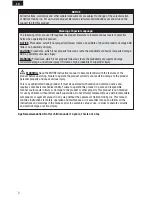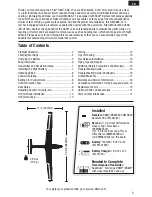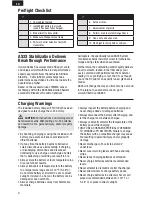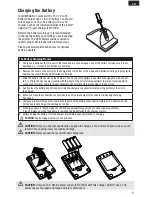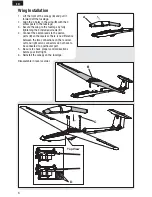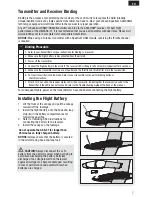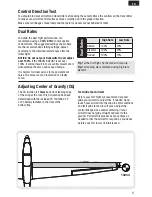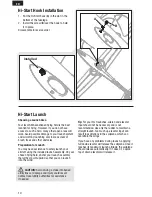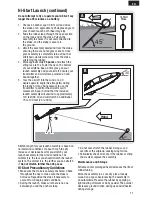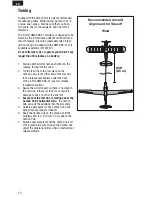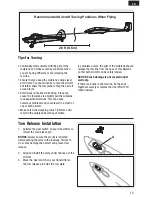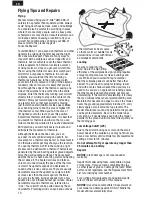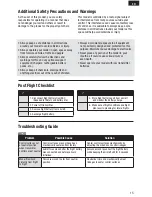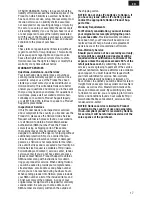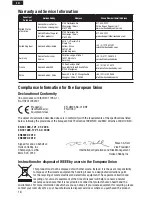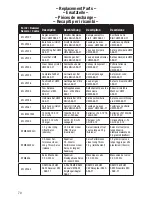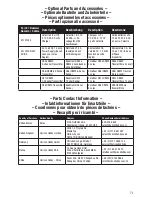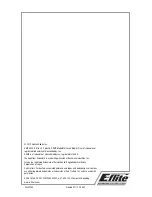
14
EN
Flying
We recommend fl ying your E-fl ite
®
UMX ASK-21
outside in no greater than moderate winds. Always
avoid fl ying near houses, trees, wires and buildings.
You should also be careful to avoid fl ying in areas
where there are many people, such as busy parks,
schoolyards or soccer fi elds. Consult local laws and
ordinances before choosing a location to fl y your
aircraft. For additional tips on fl ying your ASK-21,
please refer to the product page at
horizonhobby.com.
Your UMX ASK-21 can ascend on thermals and other
updrafts to prolong its fl ight far beyond the fl ight
time one would expect. There are many ways to
stay aloft with a sailplane, such as ridge lifts and
thermals, but we will only cover the basic thermal
in this supplement. A thermal is simply a column
of rising warm air. Once you get your aircraft into
the air using the Hi-Start or aero-tow, watch your
aircraft for a response to thermals. In a full-size
sailplane, you would feel the lift of entering a
thermal as turbulence. In the same way, watch
your aircraft for movement or rising. If the airplane
randomly rolls on its own, it is likely that you only
fl ew through the edge of the thermal, causing one
side of the airplane to rise, rather than the entire
airplane. Enter the thermal by turning your aircraft
directly into it, circling to stay in the center of the
thermal. Slow your forward speed by increasing
up elevator trim so that your aircraft is moving
just faster than stall (minimum sink speed). Make
easy banking turns to fi nd the area of highest lift
(the thermal’s core). When you fi nd the core of
lift, tighten your turns to stay near this position.
Sometimes thermals drift downwind. It is best that
you search for thermals upwind, so that you can
follow a thermal downwind if it is pushed downwind.
With practice, you will fi nd it easier to locate and
anticipate the movement of thermals.
Although thermals cannot be seen, you can
see dust, insects or birds riding an updraft. Air
movement of a thermal may be felt, so movement in
an otherwise calm spot may show you the location
of a nearby thermal. A shift in the wind (in a light
breeze) can be airfl ow into a thermal. Thermals are
generated by the sun heating darker ground objects
more than surrounding surfaces. The dark object
absorbs the sun’s heat, becoming warm and heating
the air above it. The heated air rises and forms a
column or funnel. Usually the base of the thermal
is small. The updraft expands and decreases in
speed as the air rises and cools. There are usually
downdrafts around the updraft, as cooler air falls
or moves less than the warm updraft. Thermals
can vary in strength, rising at speeds from a few
hundred to over a thousand feet per minute. Cooler
downdrafts around a thermal are referred to as
“sink.” Your aircraft can be pulled down by these
downdrafts. Prevailing wind can aso bend or break
a thermal from its heat source
so that a warm air bubble travels
downwind as it rises with little or
no attendant downdrafts.
Landing
Be sure to land into the
wind. Due to the high lifting
effi ciency of the sailplane design, landing requires
a large landing area clear of trees, buildings and
cars. While on your downwind leg, remember
that the sailplane glides much better than other
aircraft. You will need to setup for landing, lower
and with a more shallow decent than you may be
used to. As you are on approach for landing ensure
that the model is descending slowly, but also not
accelerating. If the model is accelerating, it is likely
that you will overshoot your projected landing area.
Maintain this descent and speed, and, as the model
nears the ground (approximately 6 inches (15 cm)),
slowly apply a small amount of up elevator. The
model should level out and fl y parallel to the ground
and begin to decelerate. Be sure the model does
not climb. As it decelerates, keep fl ying the model
parallel to the ground until it comes to rest gently on
the landing gear.
Low Voltage Cutoff (LVC)
Due to the aircraft having no motor and the small
power needs of the sailplane, you may not know you
have a low battery until controls fail. We recommend
setting a timer for 25 minutes.
Do not attempt to fl y or operate any longer than
25 minutes on a battery.
Repairs
NOTICE:
Crash damage is not covered under
warranty.
Repair this model using foam-compatible CA glue
or clear tape. Only use foam-compatible CA glue
as other types of glue can damage the foam. When
parts are not repairable, see the Replacement Parts
List for ordering by item number.
For a listing of all replacement and optional parts,
refer to the list at the back of this manual.
NOTICE:
Use of foam-compatible CA accelerant on
your model can damage paint. DO NOT handle the
model until accelerant fully dries.
Flying Tips and Repairs
Wind


